[English] 日本語
 Yorodumi
Yorodumi- PDB-4no0: Crystal structure of non-phosphorylated form of RQA_V phosphopept... -
+ Open data
Open data
- Basic information
Basic information
| Entry | Database: PDB / ID: 4no0 | ||||||
|---|---|---|---|---|---|---|---|
| Title | Crystal structure of non-phosphorylated form of RQA_V phosphopeptide bound to HLA-A2 in complex with LILRB1 | ||||||
 Components Components |
| ||||||
 Keywords Keywords | IMMUNE SYSTEM/ANTIGEN / Nonphosphorylated peptide / peptide-MHC complex / MHC / LILRB1 / post translational modification / peptide conformation / tumor immunology / tumor antigen / neoepitope / IMMUNE SYSTEM-ANTIGEN complex | ||||||
| Function / homology |  Function and homology information Function and homology informationHLA-A specific inhibitory MHC class I receptor activity / : / negative regulation of serotonin secretion / MHC class Ib protein complex binding / HLA-B specific inhibitory MHC class I receptor activity / immune response-inhibiting cell surface receptor signaling pathway / inhibitory MHC class I receptor activity / negative regulation of dendritic cell differentiation / Fc receptor mediated inhibitory signaling pathway / MHC class Ib receptor activity ...HLA-A specific inhibitory MHC class I receptor activity / : / negative regulation of serotonin secretion / MHC class Ib protein complex binding / HLA-B specific inhibitory MHC class I receptor activity / immune response-inhibiting cell surface receptor signaling pathway / inhibitory MHC class I receptor activity / negative regulation of dendritic cell differentiation / Fc receptor mediated inhibitory signaling pathway / MHC class Ib receptor activity / MHC class Ib protein binding / negative regulation of T cell mediated cytotoxicity / negative regulation of CD8-positive, alpha-beta T cell activation / immune response-regulating signaling pathway / negative regulation of transforming growth factor beta production / MHC class I receptor activity / negative regulation of cytokine production involved in immune response / negative regulation of alpha-beta T cell activation / dendritic cell differentiation / interleukin-10-mediated signaling pathway / negative regulation of osteoclast development / protein phosphatase 1 binding / negative regulation of T cell activation via T cell receptor contact with antigen bound to MHC molecule on antigen presenting cell / negative regulation of interleukin-12 production / negative regulation of endocytosis / negative regulation of dendritic cell apoptotic process / negative regulation of interferon-beta production / negative regulation of mononuclear cell proliferation / negative regulation of natural killer cell mediated cytotoxicity / cellular response to interleukin-7 / T cell proliferation involved in immune response / positive regulation of memory T cell activation / T cell mediated cytotoxicity directed against tumor cell target / TAP complex binding / Golgi medial cisterna / positive regulation of CD8-positive, alpha-beta T cell activation / CD8-positive, alpha-beta T cell activation / positive regulation of CD8-positive, alpha-beta T cell proliferation / positive regulation of macrophage cytokine production / negative regulation of interleukin-10 production / CD8 receptor binding / antigen processing and presentation of exogenous peptide antigen via MHC class I / beta-2-microglobulin binding / endoplasmic reticulum exit site / negative regulation of calcium ion transport / negative regulation of cell cycle / negative regulation of type II interferon production / MHC class I protein binding / TAP binding / antigen processing and presentation of endogenous peptide antigen via MHC class I via ER pathway, TAP-dependent / protection from natural killer cell mediated cytotoxicity / negative regulation of tumor necrosis factor production / antigen processing and presentation of endogenous peptide antigen via MHC class Ib / antigen processing and presentation of endogenous peptide antigen via MHC class I via ER pathway, TAP-independent / detection of bacterium / cellular defense response / T cell receptor binding / negative regulation of T cell proliferation / positive regulation of defense response to virus by host / SH2 domain binding / negative regulation of receptor binding / early endosome lumen / Nef mediated downregulation of MHC class I complex cell surface expression / DAP12 interactions / transferrin transport / cellular response to iron ion / Endosomal/Vacuolar pathway / Antigen Presentation: Folding, assembly and peptide loading of class I MHC / peptide antigen assembly with MHC class II protein complex / lumenal side of endoplasmic reticulum membrane / cellular response to iron(III) ion / negative regulation of forebrain neuron differentiation / MHC class II protein complex / antigen processing and presentation of exogenous protein antigen via MHC class Ib, TAP-dependent / ER to Golgi transport vesicle membrane / peptide antigen assembly with MHC class I protein complex / regulation of iron ion transport / regulation of erythrocyte differentiation / HFE-transferrin receptor complex / response to molecule of bacterial origin / MHC class I peptide loading complex / T cell mediated cytotoxicity / positive regulation of T cell cytokine production / antigen processing and presentation of endogenous peptide antigen via MHC class I / antigen processing and presentation of exogenous peptide antigen via MHC class II / positive regulation of immune response / MHC class I protein complex / peptide antigen binding / positive regulation of T cell activation / negative regulation of neurogenesis / positive regulation of receptor-mediated endocytosis / receptor internalization / cellular response to nicotine / positive regulation of T cell mediated cytotoxicity / multicellular organismal-level iron ion homeostasis / response to virus / specific granule lumen / positive regulation of type II interferon production / phagocytic vesicle membrane / recycling endosome membrane Similarity search - Function | ||||||
| Biological species |  Homo sapiens (human) Homo sapiens (human) | ||||||
| Method |  X-RAY DIFFRACTION / X-RAY DIFFRACTION /  MOLECULAR REPLACEMENT / MOLECULAR REPLACEMENT /  molecular replacement / Resolution: 2.7 Å molecular replacement / Resolution: 2.7 Å | ||||||
 Authors Authors | Mohammed, F. / Stones, D.H. / Willcox, B.E. | ||||||
 Citation Citation |  Journal: Oncotarget / Year: 2017 Journal: Oncotarget / Year: 2017Title: The antigenic identity of human class I MHC phosphopeptides is critically dependent upon phosphorylation status. Authors: Mohammed, F. / Stones, D.H. / Zarling, A.L. / Willcox, C.R. / Shabanowitz, J. / Cummings, K.L. / Hunt, D.F. / Cobbold, M. / Engelhard, V.H. / Willcox, B.E. | ||||||
| History |
|
- Structure visualization
Structure visualization
| Structure viewer | Molecule:  Molmil Molmil Jmol/JSmol Jmol/JSmol |
|---|
- Downloads & links
Downloads & links
- Download
Download
| PDBx/mmCIF format |  4no0.cif.gz 4no0.cif.gz | 132.1 KB | Display |  PDBx/mmCIF format PDBx/mmCIF format |
|---|---|---|---|---|
| PDB format |  pdb4no0.ent.gz pdb4no0.ent.gz | 102.4 KB | Display |  PDB format PDB format |
| PDBx/mmJSON format |  4no0.json.gz 4no0.json.gz | Tree view |  PDBx/mmJSON format PDBx/mmJSON format | |
| Others |  Other downloads Other downloads |
-Validation report
| Summary document |  4no0_validation.pdf.gz 4no0_validation.pdf.gz | 465 KB | Display |  wwPDB validaton report wwPDB validaton report |
|---|---|---|---|---|
| Full document |  4no0_full_validation.pdf.gz 4no0_full_validation.pdf.gz | 488.3 KB | Display | |
| Data in XML |  4no0_validation.xml.gz 4no0_validation.xml.gz | 25.7 KB | Display | |
| Data in CIF |  4no0_validation.cif.gz 4no0_validation.cif.gz | 34.7 KB | Display | |
| Arichive directory |  https://data.pdbj.org/pub/pdb/validation_reports/no/4no0 https://data.pdbj.org/pub/pdb/validation_reports/no/4no0 ftp://data.pdbj.org/pub/pdb/validation_reports/no/4no0 ftp://data.pdbj.org/pub/pdb/validation_reports/no/4no0 | HTTPS FTP |
-Related structure data
| Related structure data |  4nnxC 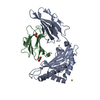 4nnyC 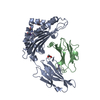 4no2C  4no3C  4no5C 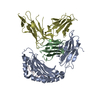 1p7qS C: citing same article ( S: Starting model for refinement |
|---|---|
| Similar structure data |
- Links
Links
- Assembly
Assembly
| Deposited unit | 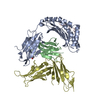
| ||||||||
|---|---|---|---|---|---|---|---|---|---|
| 1 |
| ||||||||
| Unit cell |
|
- Components
Components
-Protein , 3 types, 3 molecules ABD
| #1: Protein | Mass: 31951.316 Da / Num. of mol.: 1 / Fragment: extracellular domain (UNP residues 25-300) Source method: isolated from a genetically manipulated source Source: (gene. exp.)  Homo sapiens (human) / Gene: HLA-A, HLAA / Plasmid: pGMT7 / Production host: Homo sapiens (human) / Gene: HLA-A, HLAA / Plasmid: pGMT7 / Production host:  |
|---|---|
| #2: Protein | Mass: 11748.160 Da / Num. of mol.: 1 / Fragment: UNP residues 21-119 Source method: isolated from a genetically manipulated source Source: (gene. exp.)  Homo sapiens (human) / Gene: B2M, CDABP0092, HDCMA22P / Plasmid: pGMT7 / Production host: Homo sapiens (human) / Gene: B2M, CDABP0092, HDCMA22P / Plasmid: pGMT7 / Production host:  |
| #4: Protein | Mass: 21747.340 Da / Num. of mol.: 1 / Fragment: UNP residues 27-221 Source method: isolated from a genetically manipulated source Source: (gene. exp.)  Homo sapiens (human) / Gene: ILT2, LILRB1, LIR1, MIR7 / Plasmid: pET23a / Production host: Homo sapiens (human) / Gene: ILT2, LILRB1, LIR1, MIR7 / Plasmid: pET23a / Production host:  |
-Protein/peptide , 1 types, 1 molecules C
| #3: Protein/peptide | Mass: 1302.520 Da / Num. of mol.: 1 / Fragment: peptide (UNP residues 249-260) / Source method: obtained synthetically / Source: (synth.)  Homo sapiens (human) / References: UniProt: P33241 Homo sapiens (human) / References: UniProt: P33241 |
|---|
-Non-polymers , 2 types, 49 molecules 


| #5: Chemical | ChemComp-EDO / |
|---|---|
| #6: Water | ChemComp-HOH / |
-Details
| Has protein modification | Y |
|---|---|
| Sequence details | IN LEUKOCYTE IMMUNOGLOB |
-Experimental details
-Experiment
| Experiment | Method:  X-RAY DIFFRACTION / Number of used crystals: 1 X-RAY DIFFRACTION / Number of used crystals: 1 |
|---|
- Sample preparation
Sample preparation
| Crystal | Density Matthews: 2.87 Å3/Da / Density % sol: 57.2 % |
|---|---|
| Crystal grow | Temperature: 298 K / Method: vapor diffusion, hanging drop / pH: 7.5 Details: 18% PEG3350, 0.1 M HEPES, pH 7.4, 0.2 M ammonium acetate, VAPOR DIFFUSION, HANGING DROP, temperature 298K |
-Data collection
| Diffraction | Mean temperature: 100 K | |||||||||||||||||||||||||||||||||||||||||||||||||||||||||||||||||||||||||||||
|---|---|---|---|---|---|---|---|---|---|---|---|---|---|---|---|---|---|---|---|---|---|---|---|---|---|---|---|---|---|---|---|---|---|---|---|---|---|---|---|---|---|---|---|---|---|---|---|---|---|---|---|---|---|---|---|---|---|---|---|---|---|---|---|---|---|---|---|---|---|---|---|---|---|---|---|---|---|---|
| Diffraction source | Source:  ROTATING ANODE / Type: RIGAKU / Wavelength: 1.5417 Å ROTATING ANODE / Type: RIGAKU / Wavelength: 1.5417 Å | |||||||||||||||||||||||||||||||||||||||||||||||||||||||||||||||||||||||||||||
| Detector | Type: RIGAKU SATURN 944 / Detector: CCD / Date: Oct 21, 2009 | |||||||||||||||||||||||||||||||||||||||||||||||||||||||||||||||||||||||||||||
| Radiation | Protocol: SINGLE WAVELENGTH / Monochromatic (M) / Laue (L): M / Scattering type: x-ray | |||||||||||||||||||||||||||||||||||||||||||||||||||||||||||||||||||||||||||||
| Radiation wavelength | Wavelength: 1.5417 Å / Relative weight: 1 | |||||||||||||||||||||||||||||||||||||||||||||||||||||||||||||||||||||||||||||
| Reflection | Resolution: 2.7→29.325 Å / Num. obs: 21132 / % possible obs: 98.9 % / Observed criterion σ(I): -3 / Redundancy: 36 % / Biso Wilson estimate: 47.502 Å2 / Rmerge(I) obs: 0.126 / Net I/σ(I): 33.28 | |||||||||||||||||||||||||||||||||||||||||||||||||||||||||||||||||||||||||||||
| Reflection shell |
|
-Phasing
| Phasing | Method:  molecular replacement molecular replacement |
|---|
- Processing
Processing
| Software |
| |||||||||||||||||||||||||||||||||||||||||||||
|---|---|---|---|---|---|---|---|---|---|---|---|---|---|---|---|---|---|---|---|---|---|---|---|---|---|---|---|---|---|---|---|---|---|---|---|---|---|---|---|---|---|---|---|---|---|---|
| Refinement | Method to determine structure:  MOLECULAR REPLACEMENT MOLECULAR REPLACEMENTStarting model: PDB ENTRY 1P7Q Resolution: 2.7→29.325 Å / Cor.coef. Fo:Fc: 0.893 / Cor.coef. Fo:Fc free: 0.851 / WRfactor Rfree: 0.2545 / WRfactor Rwork: 0.2236 / Occupancy max: 1 / Occupancy min: 0 / FOM work R set: 0.7445 / SU B: 15.83 / SU ML: 0.315 / SU R Cruickshank DPI: 0.6386 / SU Rfree: 0.4092 / Cross valid method: THROUGHOUT / σ(F): 0 / ESU R: 0.639 / ESU R Free: 0.409 / Stereochemistry target values: MAXIMUM LIKELIHOOD / Details: HYDROGENS HAVE BEEN ADDED IN THE RIDING POSITIONS
| |||||||||||||||||||||||||||||||||||||||||||||
| Solvent computation | Ion probe radii: 0.8 Å / Shrinkage radii: 0.8 Å / VDW probe radii: 1.4 Å / Solvent model: MASK | |||||||||||||||||||||||||||||||||||||||||||||
| Displacement parameters | Biso max: 132.38 Å2 / Biso mean: 54.8343 Å2 / Biso min: 2.75 Å2
| |||||||||||||||||||||||||||||||||||||||||||||
| Refinement step | Cycle: LAST / Resolution: 2.7→29.325 Å
| |||||||||||||||||||||||||||||||||||||||||||||
| Refine LS restraints |
| |||||||||||||||||||||||||||||||||||||||||||||
| LS refinement shell | Resolution: 2.7→2.77 Å / Total num. of bins used: 20
|
 Movie
Movie Controller
Controller


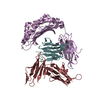
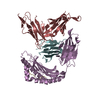
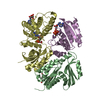
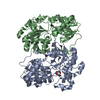
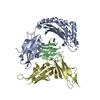

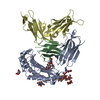
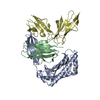
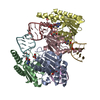
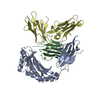
 PDBj
PDBj






